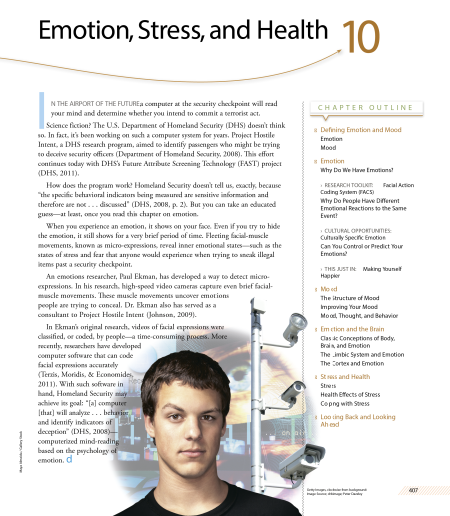Chapter 10. Emotion, Stress, and Health
10.1 Introduction
10.2 Slide 2
Welcome to your Try This! research experience for Chapter 10. In this activity, you will be presented with situations and asked to think about a few questions. The questions may seem odd at first. However, as we’ll explain at the end of this activity, they were devised to accomplish specific research goals.
The questions describe situations and behaviors, and then ask you some questions about them. So please move ahead to the next page for the first situation and questions.
10.3 Slide 3
Situation 1A: Factory owners want to increase their profits by cutting costs. One current cost is the expense of treating industrial waste products (e.g., chemical solvents), which are transported from the factory to a chemical treatment plant, where they are safely processed. To cut costs, the owners make a decision: They decide to dump the waste products into a nearby river.
Question
CqoKKtwTOirbtfcPNity+vD6W01YEfXfxybs4Yem0LgVFor+JWU83CTG6mzPnzhQBN+Iyy/kWgHXBcRxlaBYMDgzFaCKKBDeRi3flgXS4sX5PJRLAH12iQQVNsSgNj166XftEtsFexeNBUE+wgZH7g5RodYvtddo9jCD3hj8Im2fRn8uFZYyK8ki8X9w/VAu5NKOTGdEIh9oUiKzTFG8NM0DDzbt6uAvYMiaeqePG3xPckS8aCu5ghCrrycvWHeeH4QPxelltMBp5QpB36dZIeDZWXI=Question
cyUqp7dWXWy0IcTzOlVVT/Tol4i7f6taShov/nUaC0nT4CkauyL4WLfkYBHyBHCqEMa87TtD/rXyDqtwUQ7zyInFIyvRX+NxBOYHjl7JQ0uka6HgTPdGM9W184qj7usvtQDSsTGdR6I+wf9u/+qEJMxvf1A4om76hKD3mXOOg5twiRj0+e+MlCshedteYke8yNYbXfL3A/PAMN2J4IYbts/7L/HaNJUFOJ1AUSeIzNARpINUvCyULFPMJ74sKY/XCbq1hSToPcHQzctAFdDawfX3ZK041yzkqgbn8xsSy12oCvSElgZ8kzwITVI/LZn59YtvoHjl1Ryrww6OQuestion
11P9I1g6sGkH4D0jitaGxg8VXIByWjpSPPNxUXeLZlq8gAMIIi7pepWP27aypjaqyAmzbMMlmvi36E2kI8ubY/CN7IZWiv88XgERL8A8pv9VfiQQkDYbRzPOmGwnNEKiy64Rkyd9FDN5sRbHD1/4lf9qLcg/Z1Kax+641sEb25qODtv3HjDiBMKbohCafH5yMdwf1Jl0O83a8DiaOaXG+dXdnZxPhwhLNX+lNX5W8XMYfgSglZwle14KAsC3JgIUEVxEuvSNPvPNBiDFWP2EZHHVELvty/JS10.4 Slide 4
Situation 1B: A family's dog was killed by a car in front of their house. They had heard that dog meat was delicious, so they decided to cut up the dog's body, cook it, and eat it for dinner.
Question
Fakildmd4wmSqC1lzOvSRH651vU1guC/5mDfDVNcIcIGcIvy5H+2hoYQEhbyZGJeB/X6/3U8Rl4C56O8D08hjJASzvoBxkEAlEvTvNLTDxW9xCzyvBEQhCAMJMHcyLewB6pV0bxlSE8uxJBVbe9yi/r0bS5Y/TRHJ0H4h9vzPvKyWn/F2fZQZMnQYK+nwZuXN6BJBDNv+4oePUpPRj+Ir3HGYC2o4W9TAKWDEDDObZ6e6PESj7Ux6wJtppWIpXxmlcdG4UYtzOmyhZoaQuestion
2TQHBYAUunLVTPzONuncPvXoFBFQQFO6yyuq5BbTE38WPq6ffdUGE00Ej1noCR0cSKLnTqfcHwlYjpFyyPfQ24nq49Xr0NuFzv13kXdoVIhL3xDDAdmaIecDMotDR/KoBX5aBFIIIbp/y5BoHFQoz5LEEH9+E210Hx1xoBxBPMDpyxxc8bkrWRPf3jvvKzoskIBdqDtLlY/Xkb0YZHOgD2iRa6+GUJoOak+jxHcD/Qme9NsZY4bDFeKyS7BfIfImE1i4JMtNS4fqISejhr7pbk2XqF257XCcKSH+ExWwdte35lDr+nhSZTkRndQmycufHA6zo6QgQOD23G4GQuestion
11P9I1g6sGkH4D0jitaGxg8VXIByWjpSPPNxUXeLZlq8gAMIIi7pepWP27aypjaqyAmzbMMlmvi36E2kI8ubY/CN7IZWiv88XgERL8A8pv9VfiQQkDYbRzPOmGwnNEKiy64Rkyd9FDN5sRbHD1/4lf9qLcg/Z1Kax+641sEb25qODtv3HjDiBMKbohCafH5yMdwf1Jl0O83a8DiaOaXG+dXdnZxPhwhLNX+lNX5W8XMYfgSglZwle14KAsC3JgIUEVxEuvSNPvPNBiDFWP2EZHHVELvty/JS10.5 Slide 5
Situation 2A:
Suppose you see a runaway trolley (a small train) barreling down railway tracks. Ahead on the tracks are five people. The trolley is heading straight for them and they cannot move out of the way in time. Next to you is a lever. If you pull it, the trolley will switch to a different set of tracks. You notice that there is one person on this other set of tracks, and this person will be hit by the trolley if you pull the lever.
Question 10.1
NS9zI1MoJkS+yTr5EjVWrLtTAHfAo+DUK7HaKSRFNM+v6zZoAJbhuheC8zrrmAgeKJCMw61q1HeFeeaP+KgeyVP+xhUiYbPPB09Fxib7ZyZTnmiBdG9Bmsw/HydsrKo1Y/+YP1j8HitIVtHIpN7y6g48MCdM4c/FJdu9ixAyvE87N2FhiI2jbSrR8pGXlUDIbGP7bJJZk7VgUtNzt15rTCeyijkJmMX65yCSOlGlZ9OPj9qjBdPHAgvx5c/yBQfzI8nBRArdXkB8yJ9nALHlr/YMdtaycDZFzZADezi4K8SqzKorFICQMw==10.6 Slide 6
Situation 2B:
As before, a trolley is barreling down a track towards five people who cannot move out of the way in time. This time, you are on a bridge under which the trolley will pass. A very large and heavy person is next to you, leaning over the railing. You realize that you could stop the trolley, and save the five people, by pushing the person next to you over the railing and onto the train tracks; the train will hit this person and then stop.
Question 10.2
UFsnIq9Bh+gkbfpEZBt5aIIFkzw+WvcbpBS8e1eHxjUhc5p5MKE8N/zjXIUCo7LoT7VTNcKakcnnB7+xz98Ctzei7G7Cq1WCKXIXkZzllHEnMMF8S70iOMb+Jku4xoiNai53fIkRNuRdeoRCNxYvukdOr97oJJz14IbRXDD3/eMeMkrE10.7 Slide 7
Now let’s think about your results, and how your answers compare to those found in research studies.
In research studies, most people answer Yes to question A and No to question B. This is puzzling because, in terms of lives saved and lost, questions A and B are identical. Pulling the lever causes one person to be hit by the train, and saves five people. Pushing the large person over the railing causes one person to be hit by the train, and saves five people. Yet most people answer the questions differently.
Why do you think people answer the questions differently when they are the same in terms of lives saved and lost? Do you think emotions, rather than cold, calculating thinking processes, might explain this?
10.8 Activity completed!
Now think back to the earlier questions. You probably thought the factory owners’ decision (to dump industrial waste into the river) was wrong and could provide reasons why it was wrong. You also may have thought that the family’s decision (to eat their dog) was wrong. If so, you may have found it hard to explain why it was wrong. In research studies, most people think the family’s decision is wrong but can’t say why; they know intuitively that it is wrong, but can’t explain what, exactly, makes it wrong.
Do you think emotions, rather than cold, calculating thinking processes, might explain people’s intuitions when responding to the question about the family’s decision?
Return now to Chapter 10, where you’ll find out.
This activity inspired by and based on the following research:
Haidt, J., Koller, S. H., & Dias, M. G. (1993). Affect, culture, and morality, or is it wrong to eat your dog? Journal of Personality and Social Psychology, 65, 613-628.
Greene, J. D., Sommerville, R. B., Nystrom, I. E., Darley, J. M., & Cohen, J. D. (2001). An fMRI investigation of emotional engagement in moral judgment. Science, 293, 2105-2108.

